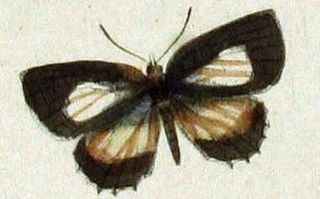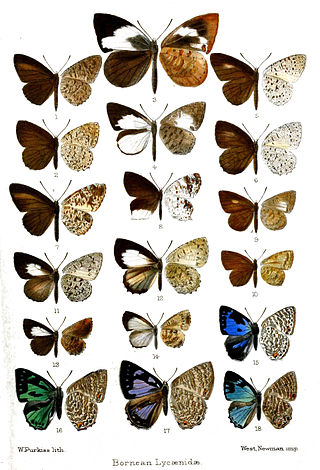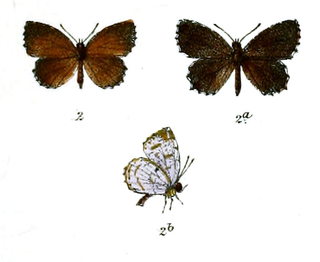
Publius Clodius Thrasea Paetus, Roman senator, who lived in the 1st century AD. Notable for his principled opposition to the emperor Nero and his interest in Stoicism, he was the husband of Arria, who was the daughter of A. Caecina Paetus and the elder Arria, father-in-law of Helvidius Priscus, and a friend and relative by marriage of the poet Persius. Thrasea was the most prominent member of the political faction known today as the Stoic Opposition.

Allotinus is a genus of butterflies in the family Lycaenidae. The genus was erected by Cajetan Felder and Rudolf Felder in 1865. The members (species) of this genus are found in the Indomalayan realm.
Sextus Aelius Paetus Catus or Sextus Aelius Q.f. Paetus Catus, was a Roman Republican consul, elected in 198 BC. Today, he is best known for his interpretation of the laws of the Twelve Tables, which is known to us only through the praise of Cicero. Paetus Catus came from a prominent plebeian noble family; his father was a praetor, and his elder brother was another consul, Publius Aelius Paetus.
The gens Aelia, occasionally written Ailia, was a plebeian family in Rome, which flourished from the fifth century BC until at least the third century AD, a period of nearly eight hundred years. The archaic spelling Ailia is found on coins, but must not be confused with Allia, which is a distinct gens. The first member of the family to obtain the consulship was Publius Aelius Paetus in 337 BC.
The Roman–Parthian War of 58–63 or the War of the Armenian Succession was fought between the Roman Empire and the Parthian Empire over control of Armenia, a vital buffer state between the two realms. Armenia had been a Roman client state since the days of Emperor Augustus, but in 52/53, the Parthians succeeded in installing their own candidate, Tiridates, on the Armenian throne.
Lucius Junius Caesennius Paetus was a Roman senator, and member of the gens Caesennia and Junia, who held several offices in the emperor's service. He was consul ordinarius for the year 61 as the colleague of Publius Petronius Turpilianus. Judith Ginsburg notes this made him the first novus homo to reach the ordinary consulship since Quintus Veranius 12 years before.

Allotinus fallax is a butterfly in the family Lycaenidae. It is found in Asia.

Allotinus nicholsi is a butterfly in the family Lycaenidae. It was described by John Coney Moulton in 1912. It is found on Borneo and Sumatra.Hans Fruhstorfer in Seitz provides a description differentiating nicholsi from nearby taxa.

Allotinus portunus is a butterfly in the family Lycaenidae. It was described by Lionel de Nicéville in 1894. It is found in Southeast Asia.
Allotinus punctatus is a butterfly in the family Lycaenidae. It was described by Georg Semper in 1889. It is found on Mindanao in the Philippines.

Allotinus albatus is a butterfly in the family Lycaenidae. It was described by father and son entomologists Cajetan and Rudolf Felder in 1865. It is found on Sulawesi and the Philippines (Luzon).
Allotinus apries is a butterfly in the family Lycaenidae. It was described by Hans Fruhstorfer in 1913. It is found in Asia.

Allotinus leogoron is a butterfly in the family Lycaenidae. It was described by Hans Fruhstorfer in 1915. It is found in Asia.

Allotinus macassarensis is a butterfly in the family Lycaenidae. It was described by William Jacob Holland in 1891. It is endemic to Sulawesi. Fruhstorfer in Seitz ( page 812 plate provides a description differentiating macassarensis from nearby taxa.

Allotinus nivalis is a butterfly in the family Lycaenidae. It was described by Herbert Druce in 1873. It is found in Southeast Asia.

Allotinus parapus is a butterfly in the family Lycaenidae. It was described by Hans Fruhstorfer in 1913. It is found on Mount Kinabalu in Borneo.Fruhstorfer in Seitz provides a description differentiating parapus from nearby taxa.
Allotinus substrigosus is a butterfly in the family Lycaenidae. It was described by Frederic Moore in 1884. It is found in Asia.

Allotinus unicolor, the lesser darkie, is a butterfly in the family Lycaenidae. It was described by Cajetan and Rudolf Felder in 1865. It is found in Asia.









